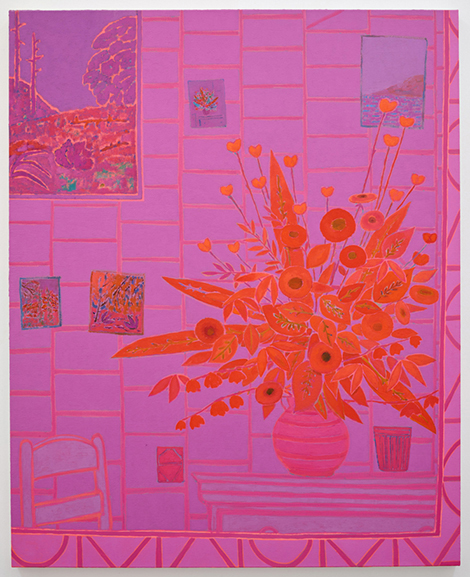Gazing out of a window or peering into a painting: both imply curiosity, perhaps driven by a sense of longing, for what is beyond. John McAllister’s paintings self-reflexively allude to this, highlighting their own window-like rectangularity while presenting snapshots of exotic mental worlds that forever lie afar.
Windows separate indoors from outdoors; likewise, paintings are semi-permeable membranes through which their creators’ visions reach viewers. Elaborating their theme of mediated separateness, McAllister’s paintings share disjunctive attributes: tensions between geometric and organic patterns; flat surfaces meeting in shallow spaces; depictions of off-kilter windows or pictures; bizarre palettes giving the impression of weirdly tinted lighting or lens filters.
The show itself is bifurcated into gallery spaces down the block from one another. The three paintings in the second space exhibit incisive chromatic explorations that benefit from the gallery’s better lighting. In Sun Fused Seeming (all works 2015), for instance, vivid scarlet flowers psychedelically vibrate in dissonance with a fuchsia background. All three paintings bristle with flickering discords that bespeak phenomenological insecurity.

John McAllister, Sun Fused Seeming, 2015, Courtesy of Richard Telles Fine Art, Los Angeles, Photo by Marten Elder
Spatial ambiguity pervades the exhibition. In conjunction with unnatural colors, pattern-like stylizations flatten depicted off-kilter rectangles, giving them an almost textile-like appearance. Are they windows, or are they paintings? It is impossible to tell. Sometimes, leafy motifs backdrop still lifes that seem equally flat. Do they belong to trees outside, paintings, or interior wallpaper? McAllister’s fluid yet deliberate touch conveys no clues. Real and unreal are leveled. His equivocal combinations of landscapes, still lifes and interiors seem best classified as dreamscapes.
Echoes of Matisse, Cezanne, Braque and Rousseau reverberate through these dreamscapes like distant memories. However, McAllister’s limited range of values, luminous synthetic palette and repeated motifs of askew oblongs seem more inspired by glowing digital screens than by other paintings.
The exhibition’s largest work, Molten Once Shed Such Chiming, a Japanese byobu painted on both sides, literally partitions its surrounding space while binding the paintings on its surfaces. At a glance, it appears decorative, an ostensive fault compounded by the fact that it lacks the chromatic ingenuity, and for its size, the precision and compositional complexity of his paintings on canvas.
However, the double-sided, elongated format affords the painting an experiential quality that reveals itself as one traverses it. Loose brushwork enhances its free-flowing dreamlike qualities. Hinged fissures in the screen divide it into sequential frames. One might pause in momentary confusion before an illusionistically painted crevice mimicking the real ones. Subordinate paintings also appear in sequence. The painting thus becomes filmic, unfolding over time. Rather than appearing as a single image, it becomes a spatiotemporal experience. Corners between junctures cast subtle shadows. One must walk around it to see the other side.
On its reverse, sub-paintings that are smaller than the ones in front appear as though tacked at haphazard intervals over a geometric structure. The back half of the painting seems suffused with light, conveying the sensation of looking through an openwork structure into resplendence diffused by a translucent screen. Magnified there, McAllister’s paintings insinuate a world that is close at hand while remaining perpetually out of reach.


